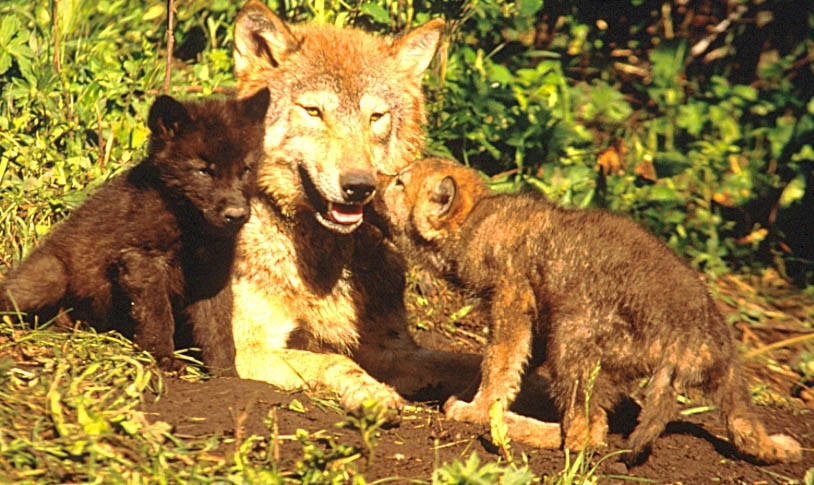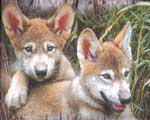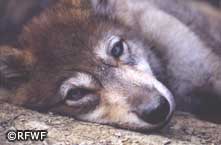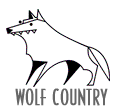
Wolf Pups
Pups are born completely blind and deaf (but have a keen sense if smell), depending on the their mother and other members of the pack. The whole pack takes care and raises the pups (non-breeding females produce milk and males compete to baby sit).
 Usually four to six pups are born together. This is called a litter, and the pups in a litter are called litter mates. Pups are born inside a den. A den is
sometimes a small cave or a hole dug out of the ground.
Usually four to six pups are born together. This is called a litter, and the pups in a litter are called litter mates. Pups are born inside a den. A den is
sometimes a small cave or a hole dug out of the ground.
(left) Picture from The ©Richard E. Flauto Wildlife Foundation
The den must be big enough for the mother and her pups. It shelters them from the weather and protects the pups from other animals that may want to hurt them. Packs sometimes use the same den year after year. At other times, they make or find a new den each year.
To Learn more about dens, Click, here.
Wolf pups at this age may be preyed upon by Golden Eagles, Bear can also prey on young pups. There are several records of a number of adult wolves decoying bears away from their pups' den until they left.
Gestation Period
Pups grow inside their mother for about 63 days before being born. At birth they weigh only one pound, and their eyes are closed. Pups grow quickly. About 12 to 15 days after they are born, they open their eyes. By two weeks of age, the pups can walk, and about a week after that, they may come out of the den for the first time. At first, they live only on milk from their mother.
The Birth and Nursing
After birth the female wolf will lick the fetal sac from the puppy's head (she will also swallow all of these membranes), this allows the pup to take its first breath. The placenta attached to the pup by the umbilical cord will be delivered along with the pup. The mother severs the cord and eats the placenta (eating the placenta provides a valuable meal when she is unable to hunt).
The female wolf will lick the puppy dry and encourages it to nurse. The pup will instinctively move to the warm underbelly and nuzzles around to find a teat. The mothers mammary glands secrete colostrum, a watery milk which contains important antibodies. During nursing the mother will clean the pups and stimulates them to urinate and defecate by licking the genital region. She swallows all of their excretions, keeping the birthing area clean and odor-free.
Stages of Development
- 10 - 13 days: the eyes open
- 3 weeks: the milk teeth appear, they start to explore the den
- 4 - 5 weeks: short trips outside the den, begin to eat meat
- 6 weeks: moving up to a mile from the den (with adult wolf)
- 6 - 8 weeks: pups are weaned, traveling to rendezvous site.
- 12 weeks: begin to travel with the pack on hunts (with adult wolves)
- 15 - 28 weeks: milk teeth are replaced
- 7 - 8 months: begin to hunt with the pack
Mortality
Pup mortality ranges from 30% to 60%. Pups die from diseases, malnutrition and starvation, life in the wild can be difficult. Wolves being very social animals are known to bury the dead pups, In R.D Lawrences' "In praise of wolves" pack members "mourn as deeply as might a human family".
The Early Years
 In a few weeks (4-5 weeks), the pups start eating meat. This is brought to them in the stomachs of the adult wolves. The pups lick around the mouth of the adult, and the food comes back up into the adult's mouth. This sounds terrible to us, but wolf pups love it!
In a few weeks (4-5 weeks), the pups start eating meat. This is brought to them in the stomachs of the adult wolves. The pups lick around the mouth of the adult, and the food comes back up into the adult's mouth. This sounds terrible to us, but wolf pups love it!
All the wolves in a pack help take care of the pups. When the pups are very small, other pack members bring food to the mother so she does not have to leave the den. When the pups are a little bigger, pack members "take turns" bringing them food, playing with them and even "baby sitting." Once the pups are about eight weeks old, they leave the den and start using "rendezvous sites." These are meeting places where the wolves gather to sleep, play and just "hang out." Until the pups are old enough to go with the adults, (when pups are six months old, they look almost like adult wolves. Around this time, they start hunting with the rest of the pack) they stay at the rendezvous site. Often, one of the adult wolves stays with the pups to watch over them.
 Wolf pups love to play. They chase each other and roll around the way dog puppies do. Many of their games appear to be a sort of practice for the things they will do as adult wolves. Pups have been observed playing with "toys" like bones, feathers or the skins of dead animals. They "kill" the toys over and over again and carry them around as "trophies." As they get bigger, they begin to hunt small animals, like rabbits. This is all good practice for the day they join the pack for their first real hunt for large animals.
Wolf pups love to play. They chase each other and roll around the way dog puppies do. Many of their games appear to be a sort of practice for the things they will do as adult wolves. Pups have been observed playing with "toys" like bones, feathers or the skins of dead animals. They "kill" the toys over and over again and carry them around as "trophies." As they get bigger, they begin to hunt small animals, like rabbits. This is all good practice for the day they join the pack for their first real hunt for large animals.
Eye Color
 Most wolf pups are born with blue eyes, which gradually change to a yellow-gold color by eight to sixteen weeks, though sometimes their eyes can change color much later. Occasionally, a mature wolf will be found with blue eyes.
Most wolf pups are born with blue eyes, which gradually change to a yellow-gold color by eight to sixteen weeks, though sometimes their eyes can change color much later. Occasionally, a mature wolf will be found with blue eyes.
Pup Howl
More Wolf Sounds!
